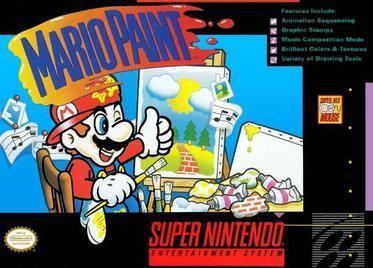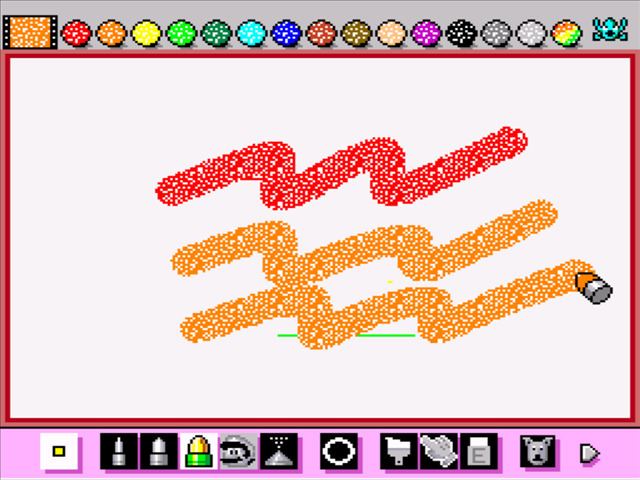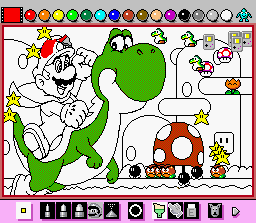Director(s) Hirofumi Matsuoka Artist(s) Hirofumi Matsuoka Initial release date 14 July 1992 Designer Shigeru Miyamoto | Genre Video game art | |
 | ||
Programmer(s) Noriaki TeramotoKenji ImaiKenji NakamuraGenji Kubota Composer(s) Hirokazu TanakaRyoji YoshitomiKazumi Totaka Publishers Nintendo, Playtronic Industrial Ltda. Similar Super Mario All‑Stars, Super Mario World, Super Mario Kart, Mario's Time Machine, Super Mario RPG | ||
Evolution of video games epic medley made in mario paint composer
Mario Paint (Japanese: マリオペイント, Hepburn: Mario Peinto) is a video game released in 1992 by Nintendo for use with the Super NES. It is packaged with the Super NES Mouse peripheral.
Contents
- Evolution of video games epic medley made in mario paint composer
- Mario paint snes video game james mike
- Gameplay
- Successors
- Reception
- In video games
- In movies
- References

Mario paint snes video game james mike
Gameplay

Aside from being a basic drawing utility, Mario Paint allows the user to make custom stamps pixel-by-pixel. Several publications, such as Nintendo Power, released guides on how to create iconic Nintendo related stamps for use within Mario Paint. In addition to just creating static pictures, a user can make simple looping animations which can then be set to music created in the music generator. These animations painted by the user can only be viewed on a television screen, and while instructions were provided to users on how to record these to a video cassette recorder, there is no other way to export any of the work done in Mario Paint.

In addition, the standard features include 60 different textures and patterns, 75 different stamps, 15 customizable stamps, and 9 different special eraser transition effects between scenes.

Mario Paint contains a fly-swatting mini-game, Gnat Attack, which is a fast-paced action game that takes full advantage of the mouse peripheral. The player controls a gloved hand (similar to the one seen on the title screen) holding a flyswatter, which must swat flying insects on the screen, before the insect stings the player's hand in one way or another. There are three levels, each with 100 insects and a boss. When you defeat the last boss it takes you back to level one and adds a small icon in the top left corner of the screen. There is no final level or reward, as the game will loop endlessly.
The title screen for Mario Paint is an Easter egg mini-game. The user is able to click each letter in the title to trigger a certain action. Certain letters cause the music to change, have Yoshi run by on screen, make Mario shrink and grow, allow the user to temporarily paint the background, and other features.
Successors
A downloadable version was released in Japan via the Satellaview broadcast service in 1997. Titled Mario Paint: BS Edition (マリオペイントBS版), this version was modified to use a standard controller without the need of a mouse device.
A sequel to Mario Paint was titled Mario Paint 64 in development, and then released in 1999 as the Japan-exclusive Mario Artist: Paint Studio launch title for the 64DD. Nintendo had commissioned the joint developer Software Creations, who described the game's original 1995 design idea as "a sequel to Mario Paint in 3D for the N64". Paint Studio has been described by IGN and Nintendo World Report respectively, as being Mario Paint's "direct follow-up" and "spiritual successor". Likewise bundled with its system's mouse, Paint Studio includes minigames such as a fly swatting game reminiscent of that in Mario Paint.
Reception
Calling Mario Paint "perhaps the most ingenious and inspired idea Nintendo ever came up with for a product", AllGame rated it 5 out of 5 stars. In 2006, it was rated the 162nd best game made on a Nintendo system in Nintendo Power's Top 200 Games list. In 2014, IGN ranked it as the 105th best Nintendo game in its list of "The Top 125 Nintendo Games of All Time". IGN editor Peer Schneider cited the game's "smart and playful interface" as a "game changer" and commented that "It effectively erased the barriers between creating and playing, making it one of the most memorable and unique games to ever be released on a console."
US Gamer calls Mario Paint "an era-appropriate solution to graphics programs on expensive PCs" which is "at least somewhat responsible for our modern era of 2D indie throwback games". It says, "Every single element ... is engineered to make the act of creation fun in and of itself, even if you're just aimlessly doodling."
In video games
Prominent video game developers have cited Mario Paint as an inspiration. Masahito Hatakeyama, one of the designers of 2009's WarioWare D.I.Y. for Nintendo DS, cites Mario Paint's drawing and music creation tools as inspiration for the drawing and music creation tools in D.I.Y., while several staff members of the development team cited it as the game that taught them the joy of developing video games. WarioWare D.I.Y. allows players to record notes via the DS microphone, and apply noises and animals sounds to them, similar to Mario Paint's music creation. WarioWare D.I.Y. uses a paint program based upon the idea of Mario Paint when the player makes a comic or graphics for their custom microgame. When "Mario Paint" is entered as the name for a microgame or comic, the Mario Paint theme will play. Some of Mario Paint's sound effects and musical instruments appear in this game.
Another counterpart appears in 2004's WarioWare: Touched! as Wario Paint, allowing the player to use the Nintendo DS stylus to color various characters in the game. "Totaka's Song" can be played with the toy Turntable in the Toy Room. The fly-swatting game makes an additional appearance in the preceding game, WarioWare, Inc.: Mega Microgame$. The Wii Photo Channel features editing functionality similar to Mario Paint, and includes several of the special erasers.
Takashi Tezuka, producer of Super Mario Maker for Wii U, stated that he "was inspired to bring the fun of Mario Paint into this course editor to make something fun and creative for people to enjoy". It includes the interactive title screen Easter eggs and the fly swatting minigame. US Gamer called Mario Paint an essential part of "the road to Super Mario Maker".
One of the sound staff from Mario Paint, Hirokazu Tanaka, later worked on EarthBound, where some of Mario Paint's sound effects and instrument patches appear.
A remixed Mario Paint song medley can be played in the Miiverse stage in Super Smash Bros. for Wii U.
In movies
The first episode of Homestar Runner in 1996 was animated using Mario Paint. A primitive introduction video made with Mario Paint can be found in the museum of the site. A later short in the series, "Strong Bad is a Bad Guy", was made using Mario Paint.
